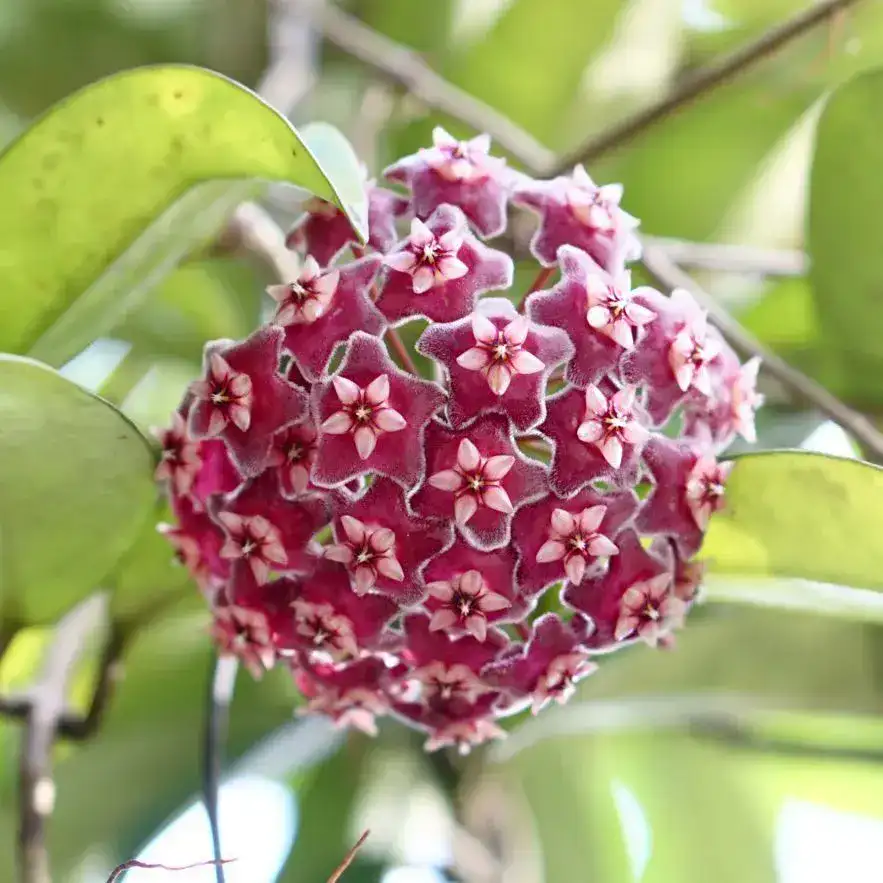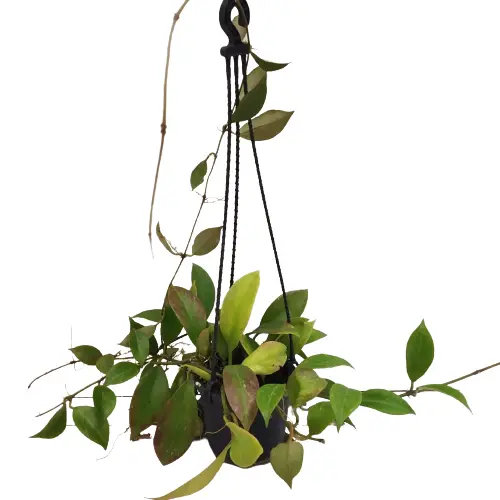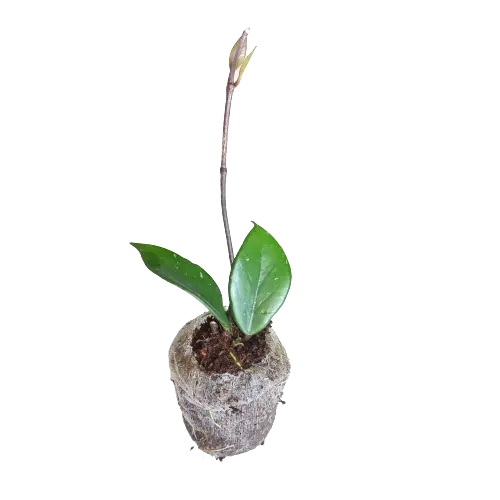Hoya Maroon Flower
Original price was: ₹220.00.₹99.00Current price is: ₹99.00.
Out of stock
Email when stock available
Selling Size: Well rooted plant in a Jiffy bag
Hoya Maroon Flower (often a cultivar of Hoya carnosa or similar species) is a popular and relatively easy-to-care-for houseplant known for its attractive foliage and clusters of fragrant, star-shaped flowers.

Here’s a comprehensive guide to Hoya Maroon Flowers care, with a focus on encouraging those beautiful blooms:
1. Light:
- Bright, Indirect Light is Key: This is arguably the most crucial factor for Hoya ‘Maroon’ to thrive and flower. They prefer bright, indirect light, similar to how they would receive filtered light through a tree canopy in their native environment.
- Avoid Direct Sun: Too much direct afternoon sun can scorch the leaves, especially intense midday sun. An east or north-facing window is often ideal. Some morning sun can be beneficial.
- Low Light Tolerated (But No Blooms): While Hoyas can survive in lower light conditions, they will grow slowly and are unlikely to produce flowers. If your plant isn’t blooming, consider moving it to a brighter spot.
- Rotate: Rotate your plant every few weeks to ensure even growth and light exposure on all sides.
- Grow Lights: If natural light is limited, especially in winter, grow lights can be a game-changer for keeping your Hoya active and encouraging blooms.
2. Watering:
- “Less is More” Approach: Hoyas are somewhat succulent, storing water in their thick, waxy leaves. They prefer to dry out between waterings. Overwatering is the most common mistake and can lead to root rot.
- Allow Soil to Dry: Water thoroughly until water drains from the bottom of the pot, then allow the top 1-2 inches of soil to dry out completely before watering again. For thicker-leaved varieties like Hoya carnosa, it’s better to slightly underwater.
- Check Soil Moisture: Stick your finger about an inch or two into the soil. If it feels dry, it’s time to water. You can also lift the pot – a dry pot will feel significantly lighter.
- Adjust for Seasons: Water more frequently during the active growing season (spring and summer) and significantly reduce watering in the fall and winter when the plant is dormant.
- Water Temperature: Use room-temperature water to avoid shocking the roots.
- Drainage is Essential: Always use a pot with drainage holes and empty any excess water from the saucer. Never let the plant sit in standing water.
3. Humidity and Temperature:
- Humidity Lovers: As tropical plants, Hoyas love high humidity. Ideal indoor humidity levels are between 60-80%.
- Increasing Humidity: If your home is dry, especially in winter, consider:
- Using a humidifier near the plant.
- Placing the pot on a pebble tray filled with water (ensure the pot isn’t sitting directly in the water).
- Grouping plants together to create a natural humidity pocket.
- Misting can offer a temporary boost, but consistent humidity is better achieved with humidifiers or pebble trays.
- Warm Temperatures: Hoyas thrive in warm temperatures, ideally between 60°F and 85°F (18°C to 29°C). Avoid cold drafts and sudden temperature changes, as these can stress the plant.

4. Soil and Potting:
- Well-Draining, Airy Mix: Hoyas are epiphytes in nature, meaning they grow on other plants (like trees) rather than in soil. This means they need a well-draining, airy potting mix that mimics their natural environment.
- Recommended Mix: A good mix typically includes:
- Orchid bark
- Perlite or pumice
- A general-purpose potting mix or succulent/cactus mix.
- You can also add charcoal or coco coir for aeration and drainage.
- Root-Bound Preference: Hoyas actually prefer to be slightly root-bound, as this can encourage flowering. Avoid repotting too frequently. Only repot when the plant is significantly root-bound (roots circling aggressively) or the substrate is breaking down, usually every 2-3 years.
- Pot Size: When repotting, only go up one pot size (2-3 cm larger than the current root ball). An oversized pot can lead to excess moisture and root rot. Terracotta pots can also help with airflow and faster drying.
5. Fertilization:
- During Growing Season: Fertilize your Hoya ‘Maroon’ once a month during the spring and summer (the active growing season).
- Diluted Fertilizer: Use a balanced, water-soluble houseplant fertilizer diluted to half or even quarter strength. Hoyas are sensitive to over-fertilization and salt buildup, which can burn their roots.
- Orchid Fertilizer: Some growers recommend orchid bloom fertilizer, as Hoyas are epiphytes like orchids.
- Avoid Winter Fertilizing: Do not fertilize during the dormant fall and winter months.
6. Pruning:
- Don’t Cut Tendrils/Peduncles: Hoyas send out long, bare tendrils that will eventually develop leaves and flower spurs (peduncles). Do not cut these tendrils! They will also re-bloom from the same peduncles year after year, so avoid removing them.
- Pruning for Shape/Bushiness: You can trim back long stems just above a leaf node to encourage a bushier appearance or to manage the plant’s size for aesthetic purposes. Use sterile scissors or shears.
7. Pests and Diseases:
- Generally Resilient: Hoyas are generally hardy, but they can be susceptible to common houseplant pests.

- Common Pests:
- Mealybugs: Look for small, white, fuzzy insects in leaf axils or on stems. Treat with rubbing alcohol on a cotton swab or insecticidal soap.
- Spider Mites: Tiny spider-like insects that can cause yellowing leaves and fine webbing. Increase humidity and treat with neem oil or insecticidal soap.
- Scale: Small, oval, immobile bumps on stems and leaves. Scrape them off and treat with insecticidal soap or rubbing alcohol.
- Diseases:
- Root Rot: The most common issue, caused by overwatering and poor drainage. Symptoms include yellowing, drooping, or mushy leaves, and soft stems. If suspected, unpot the plant, inspect roots, remove any mushy or black roots, and repot in fresh, well-draining soil in a pot with good drainage.
- Leaf Spot: Fungal disease appearing as brown or black spots. Ensure good air circulation and avoid overwatering. Remove affected leaves.
By following these care tips, your Hoya ‘Maroon’ should thrive and reward you with its beautiful and often fragrant blooms!
Only logged in customers who have purchased this product may leave a review.












 If you need any assistance, I'm always here. Have you found what you were looking for?
If you need any assistance, I'm always here. Have you found what you were looking for?
Reviews
There are no reviews yet.